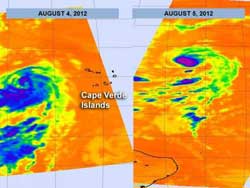NASA watches Tropical Storm Florence develop and weaken

The AIRS instrument that flies on NASA's Aqua satellite captured these infrared images of Florence on Aug. 4-5. The AIRS image from Aug. 4 showed a larger spiraled storm. By Aug. 5 when dry air started interacting with the system the area of stronger thunderstorms had diminished and the storm had a tight, small area of strong, high, cold cloud tops of thunderstorms around the center of circulation.<br><br>Credit: NASA/JPL, Ed Olsen<br>
On Friday, August 3, the low pressure area known as “System 90L” was being watched for development. It was located south of the Cape Verde Islands off the African coast. By the early evening (Eastern Daylight Time) it quickly organized. System 90L strengthened and became Tropical Storm Florence in the eastern Atlantic. Over August 4 and 5 Florence traveled west and weakened back to a tropical depression by August 6.
NASA's Aqua satellite passed over Tropical Storm Florence on August 4 and 5. The Atmospheric Infrared Sounder (AIRS) instrument onboard the satellite captured infrared images of the storm on both days. The AIRS image from Aug. 4 showed a larger spiraled storm. By Aug. 5 when dry air started interacting with the system the area of stronger thunderstorms had diminished and the storm had a tight, small area of strong, high, cold cloud tops of thunderstorms around the center of circulation.
On August 6 at 0900 UTC (5 a.m. EDT), Florence's maximum sustained winds were near 35 mph (55 kmh) with higher gusts. At 5 a.m. EDT the center of tropical depression Florence was located near latitude 16.2 north and longitude 38.8 west. Florence is moving toward the west near 12 mph (19 kmh). The depression is expect to move in a westward or west-northwestward motion and speed up over the next couple of days.
After Florence became a tropical storm she ran into dry air and Saharan dust, according to the National Hurricane Center (NHC). At 5 a.m. EDT on Monday, August 6, the NHC noted “the cyclone has been devoid of deep convection for about six hours as dry air has become well embedded in the circulation.”
Forecasters at the National Hurricane Center expect Florence to track west across the Atlantic and south of Bermuda. On her western track, Florence is expected to degenerate to a remnant low within the next couple of days, because wind shear will increase from the west and batter the storm. Florence became a post-tropical storm on August 6 at 11 a.m. EDT as its winds dropped to 35 mph (55 kmh). It was located near latitude 16.4 north and longitude 40.2 west. Florence is expected to weaken further over the next couple of days.
Media Contact
More Information:
http://www.nasa.govAll latest news from the category: Earth Sciences
Earth Sciences (also referred to as Geosciences), which deals with basic issues surrounding our planet, plays a vital role in the area of energy and raw materials supply.
Earth Sciences comprises subjects such as geology, geography, geological informatics, paleontology, mineralogy, petrography, crystallography, geophysics, geodesy, glaciology, cartography, photogrammetry, meteorology and seismology, early-warning systems, earthquake research and polar research.
Newest articles

Superradiant atoms could push the boundaries of how precisely time can be measured
Superradiant atoms can help us measure time more precisely than ever. In a new study, researchers from the University of Copenhagen present a new method for measuring the time interval,…

Ion thermoelectric conversion devices for near room temperature
The electrode sheet of the thermoelectric device consists of ionic hydrogel, which is sandwiched between the electrodes to form, and the Prussian blue on the electrode undergoes a redox reaction…

Zap Energy achieves 37-million-degree temperatures in a compact device
New publication reports record electron temperatures for a small-scale, sheared-flow-stabilized Z-pinch fusion device. In the nine decades since humans first produced fusion reactions, only a few fusion technologies have demonstrated…





















